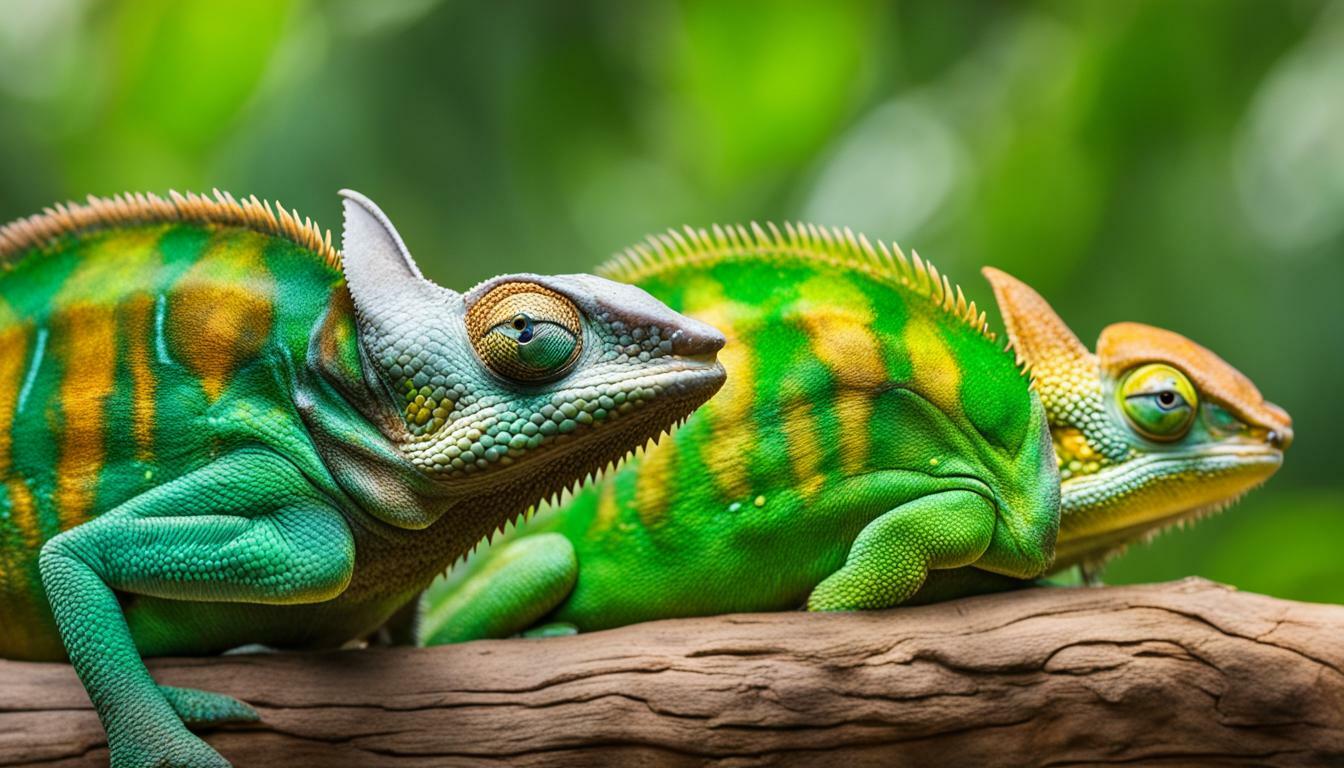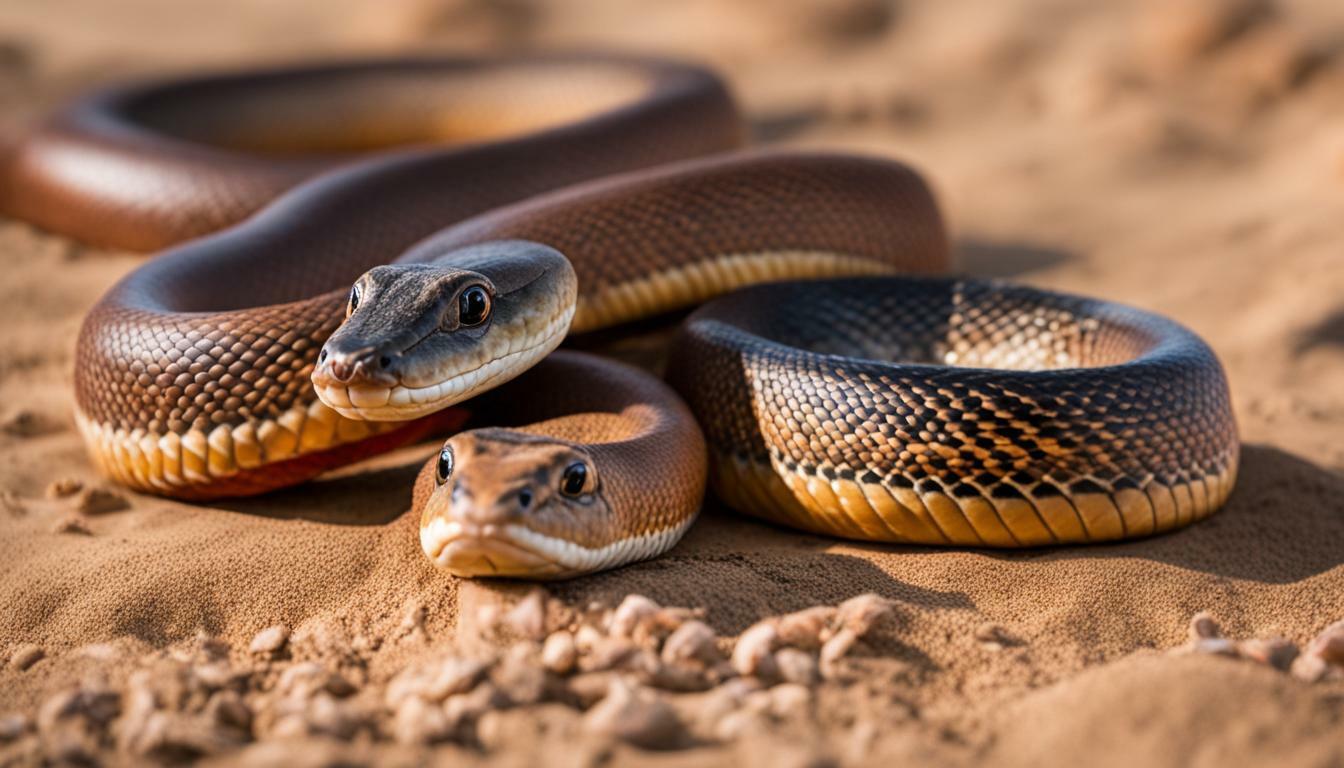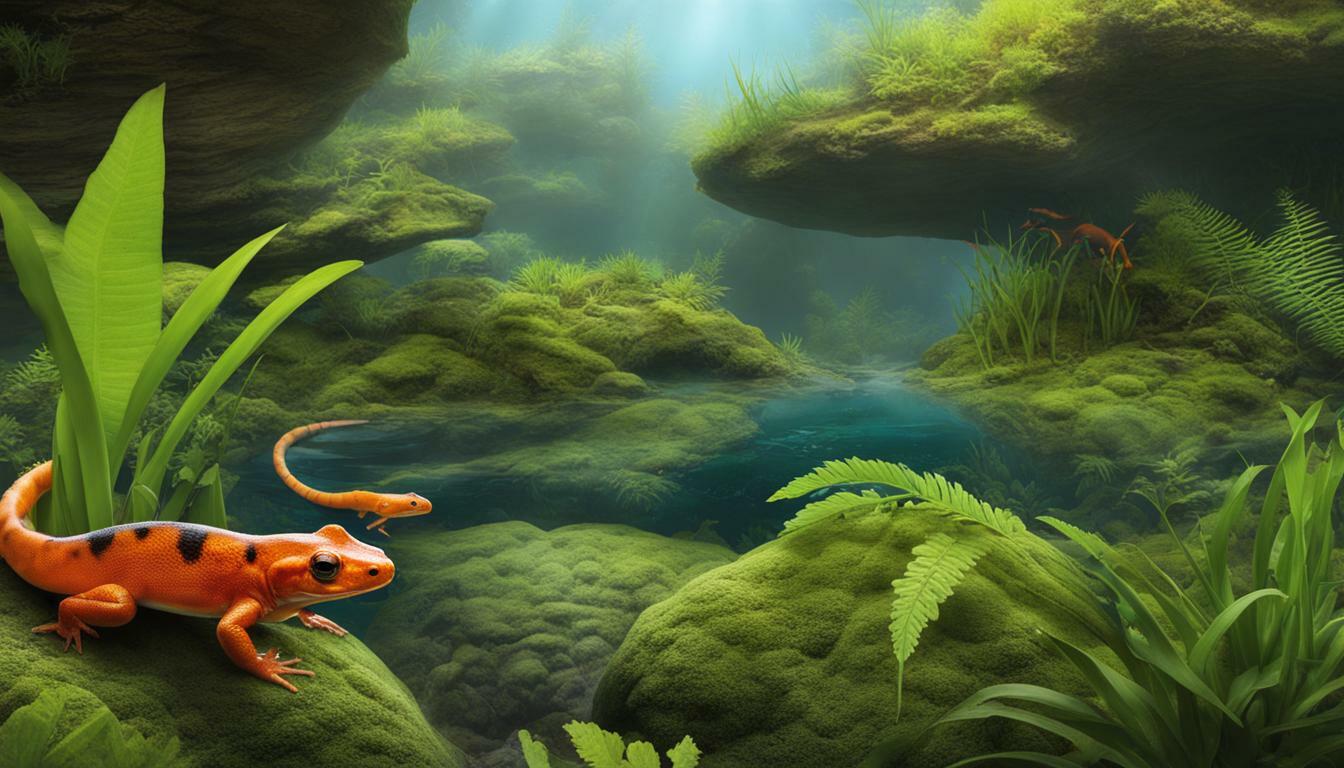Jackson’s Chameleons and Veiled Chameleons have distinct characteristics and care requirements that differentiate them from each other. Let’s explore the key differences between these two fascinating reptiles.
Key Takeaways:
- Jackson’s Chameleons require more water and higher humidity compared to Veiled Chameleons.
- Veiled Chameleons can tolerate slightly hotter temperatures than Jackson’s Chameleons.
- Jackson’s Chameleons are montane species and require less supplementation compared to Veiled Chameleons.
- Veiled Chameleons have the tendency to eat vegetation along with insects, while Jackson’s Chameleons are less likely to eat vegetation.
- Veiled Chameleons are invasive and illegal on Maui, posing a threat to native Hawaiian biodiversity.
Now, let’s delve deeper into the unique characteristics and care requirements of Jackson’s Chameleons and Veiled Chameleons.
Characteristics and Habitat
Jackson’s Chameleons and Veiled Chameleons have different physical characteristics and habitat preferences that make them easily distinguishable.
Starting with their physical appearance, Jackson’s Chameleons have three horns on their head, irregular splotchy patterns on their body, and shorter, stocky legs. Growing up to 10 inches in length, they are relatively smaller compared to Veiled Chameleons. On the other hand, Veiled Chameleons have a bony shield on their head and a fleshy fringe from under their nose down the middle line of their belly to the base of their tail. With long and thin legs, they can reach up to 2 feet in length. These distinctive characteristics provide a clear visual contrast between the two species.
In terms of habitat, Jackson’s Chameleons are montane species, which means they prefer cooler temperatures and slightly higher humidity. They require more water and humidity compared to Veiled Chameleons. On the other hand, Veiled Chameleons can tolerate drier environments and prefer slightly warmer temperatures. These differences in habitat preferences play a crucial role in their care requirements and overall well-being.
It is important to note that Jackson’s Chameleons are less likely to eat vegetation, focusing mainly on insects, while Veiled Chameleons have a more varied diet, including vegetation and insects. This dietary difference also contributes to their distinctive characteristics and care requirements.
| Species | Physical Characteristics | Habitat Preferences |
|---|---|---|
| Jackson’s Chameleons | Three horns on head Irregular splotchy patterns on body Shorter, stocky legs Up to 10 inches in length |
Montane species Cooler temperatures Higher humidity Requires more water |
| Veiled Chameleons | Bony shield on head Fleshy fringe from nose to tail Long, thin legs Up to 2 feet in length |
Tolerates drier environments Slightly warmer temperatures Tolerates lower humidity Can eat vegetation and insects |
Care Requirements
Caring for Jackson’s Chameleons and Veiled Chameleons involves varying levels of attention to their specific needs and requirements. These beautiful creatures have distinct differences in terms of their care, which should be considered when deciding to keep them as pets.
Water and Humidity
One of the key differences between Jackson’s Chameleons and Veiled Chameleons is their water and humidity requirements. Jackson’s Chameleons require more water and higher humidity levels compared to Veiled Chameleons. It is important to provide ample water sources, such as misting their enclosure regularly and providing a drip system for hydration. Additionally, maintaining humidity levels around 60-80% is essential for Jackson’s Chameleons to thrive.
Temperature and Supplementation
Another difference lies in the preferred temperatures and supplementation needs. Jackson’s Chameleons are montane species, meaning they come from higher elevations and prefer slightly cooler temperatures ranging from 70-80°F during the day and dropping to around 60-70°F at night. They require less supplementation compared to Veiled and Panther Chameleons, as they are less likely to eat vegetation.
Diet and Care Complexity
When it comes to diet and care complexity, Veiled Chameleons and Jackson’s Chameleons also differ. Veiled Chameleons are known to eat vegetation along with insects, requiring a more varied diet. Jackson’s Chameleons, however, are less likely to eat vegetation and have simpler dietary requirements. In terms of care complexity, Jackson’s Chameleons can be a bit more needy and less forgiving, requiring meticulous attention to their specific needs.
| Species | Water and Humidity Needs | Temperature Range | Dietary Requirements |
|---|---|---|---|
| Jackson’s Chameleons | More water, high humidity (60-80%) | 70-80°F during the day, 60-70°F at night | Less likely to eat vegetation, simpler dietary requirements |
| Veiled Chameleons | Less water, lower humidity (40-60%) | 80-90°F during the day, 70-75°F at night | Eat both insects and vegetation, more varied diet |
In conclusion, caring for Jackson’s Chameleons and Veiled Chameleons involves understanding and meeting their specific care requirements. From water and humidity needs to temperature ranges and dietary preferences, these chameleon species have distinct differences that should be taken into consideration to ensure their optimal health and well-being. So, whether you choose a Jackson’s Chameleon or a Veiled Chameleon as your companion, be sure to provide diligent care tailored to their individual needs.
Ecological Impact
Veiled Chameleons have a significant ecological impact, particularly in their invasive presence on Maui, where they pose a threat to native species. These chameleons, originally from Yemen and Saudi Arabia, were introduced to the Hawaiian Islands through the pet trade. Their ability to thrive in varied habitats and reproduce rapidly has led to their status as an invasive species.
The spread of Veiled Chameleons on Maui has raised concerns among environmental authorities and conservationists. They compete with native Hawaiian birds, plants, and insects for resources, disrupting the delicate balance of the ecosystem. This interference can lead to a decline in the populations of native species, including endangered and endemic species that are already facing numerous threats.
To combat the invasive presence of Veiled Chameleons, the Maui Invasive Species Committee encourages the public to report sightings and take appropriate action. If you encounter a Veiled Chameleon on Maui, it is advised to capture it and notify the authorities. Prompt reporting and intervention can help protect the native biodiversity and preserve the unique habitats of the Hawaiian Islands.
Reporting Sightings
Reporting sightings of Veiled Chameleons is crucial for effective management and control of this invasive species. The Maui Invasive Species Committee has developed a comprehensive reporting system that allows residents and visitors to easily report the presence of Veiled Chameleons. By providing accurate information about the location, number, and behavior of chameleons, individuals can contribute to monitoring efforts and help prevent further spread.
| Reporting Contact | Phone Number | |
|---|---|---|
| Maui Invasive Species Committee | (808) 573-6472 | [email protected] |
By working together and taking immediate action when encountering Veiled Chameleons, we can protect Maui’s native species and preserve the island’s unique ecological heritage for future generations.
Physical Appearance
Jackson’s Chameleons and Veiled Chameleons possess distinct physical characteristics that allow for easy identification and differentiation. Veiled Chameleons have a bony shield on their head and a fleshy fringe from under their nose down the middle line of their belly to the base of their tail. Their legs are long and thin, and they can grow up to 2 feet in length. On the other hand, Jackson’s Chameleons have three horns on their head, irregular splotchy patterns on their body, and shorter, stocky legs. They grow up to 10 inches in length.
These unique features make it easy to spot the difference between these two chameleon species. While Veiled Chameleons have a more slender and elongated appearance, Jackson’s Chameleons have a more robust and compact build. The horns on the head of Jackson’s Chameleons are particularly noticeable and serve as one of their defining characteristics.
When it comes to coloration, both species can change their skin color to blend in with their surroundings. However, Veiled Chameleons generally have a more vibrant color palette, ranging from bright greens to yellows and blues, whereas Jackson’s Chameleons tend to exhibit more subdued hues, such as greens and browns. These color variations are essential for camouflage and protection from predators in their natural habitats.
| Veiled Chameleons | Jackson’s Chameleons |
|---|---|
| Long and thin legs | Short and stocky legs |
| Bony shield on head | Three horns on head |
| Fleshy fringe from nose to tail | Irregular splotchy patterns on body |
| Grows up to 2 feet in length | Grows up to 10 inches in length |
In conclusion, the physical appearance of Jackson’s Chameleons and Veiled Chameleons is distinct and easily recognizable. Their differences in body structure, patterns, coloration, and size make them unique and fascinating creatures to observe and learn about.
Conclusion
Understanding the differences between Jackson’s Chameleons and Veiled Chameleons is essential for proper care and appreciation of these unique reptiles. These two species have distinct characteristics, care requirements, and ecological impacts.
When it comes to care, Jackson’s Chameleons require more water and higher humidity compared to Veiled Chameleons. They also prefer slightly cooler temperatures. Being montane species, Jackson’s Chameleons need less supplementation and are less likely to eat vegetation. In contrast, Veiled Chameleons will eat both insects and vegetation. Jackson’s Chameleons can be more demanding in terms of care, while Veiled Chameleons are generally more forgiving.
In addition to care differences, there are ecological considerations. Veiled Chameleons are invasive and illegal on Maui, posing a threat to native Hawaiian biodiversity. They lay numerous eggs multiple times a year, exacerbating their impact. If you come across a Veiled Chameleon on Maui, it is important to capture it and report it to the Maui Invasive Species Committee.
Visually, Jackson’s Chameleons and Veiled Chameleons have distinct appearances. Veiled Chameleons have a bony shield on their head and a fleshy fringe from under their nose down the middle line of their belly to the base of their tail. Their legs are long and thin, and they can grow up to 2 feet in length. On the other hand, Jackson’s Chameleons have three horns on their head, irregular splotchy patterns on their body, and shorter, stocky legs. They typically grow up to 10 inches in length.
In conclusion, understanding the differences between Jackson’s Chameleons and Veiled Chameleons is crucial for their proper care and for promoting the preservation of their habitats. These reptiles offer fascinating glimpses into the natural world and should be appreciated while ensuring their well-being and the protection of native ecosystems.
FAQ
What are the main differences between Jackson’s chameleons and veiled chameleons?
Jackson’s chameleons require more water and higher humidity compared to veiled chameleons. They also prefer slightly cooler temperatures. Jackson’s chameleons are montane species, which means they require less supplementation than veiled and panther chameleons. They are also less likely to eat vegetation.
Are male or female chameleons easier to care for?
Generally, male chameleons may be easier to care for due to the decreased complexity in care related to egg production for females.
Why are veiled chameleons illegal on Maui?
Veiled chameleons are invasive and pose a threat to native Hawaiian birds, plants, and insects. They lay a large number of eggs multiple times per year. If you encounter a veiled chameleon on Maui, it is advised to capture it and report it to the Maui Invasive Species Committee.
What are the physical characteristics of veiled chameleons?
Veiled chameleons have a bony shield on their head and a fleshy fringe from under their nose down the middle line of their belly to the base of their tail. Their legs are long and thin, and they can grow up to 2 feet in length.
What are the physical characteristics of Jackson’s chameleons?
Jackson’s chameleons have three horns on their head, irregular splotchy patterns on their body, and shorter, stocky legs. They grow up to 10 inches in length.
 Skip to main content
Skip to main content


